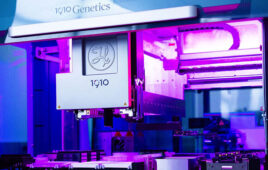
The Porpoise Galaxy, captured by the Hubble Space Telescope [Image from NASA]
Heralded as a “Hubble Space Telescope” of genomics, the technology can simultaneously compare 1.4 million genetic sequences, according to the research, published today in Nature Biotechnology. The researchers from the Centre for Genomic Regulation in Barcelona say their development may reconstruct how life has evolved over hundreds of millions of years and makes important inroads for the ambition to understand the code of life for every living species on Earth.
The most common way scientists study these relationships is by using Multiple Sequence Alignments (MSA), a tool that can be used to describe the evolutionary relationships of living organisms by looking for similarities and differences in their biological sequences, finding matches among seemingly unrelated sequences and predicting how a change at a specific point in a gene or protein might affect its function. The technology underpins so much biological research that the original study describing it is one of the most cited papers in history.
“We currently use multiple sequence alignments to understand the family tree of species evolution,” said researcher and lead author Cédric Notredame in a news release. “The bigger your MSA, the bigger the tree and the deeper we dig into the past and find how species appeared and separated from each other.
“What we’ve made lets us dig 10 times deeper than what we’ve been able to do before, helping us to see hundreds of millions of years into the past. Our technology is essentially a time machine that tells us how ancient constraints influenced genes in a way that resulted in life as we know today, much like how the Hubble Space Telescope observes things that happened millions of years ago to help us understand the Universe we live in today.”
Researchers can use MSA to understand how certain species of plants have evolved to be more resistant to climate change, or how particular genetic mutations in one species makes them vulnerable to extinction, the release said. By studying a living organism’s evolutionary history, scientists may come up with and test new ideas to stave off the collapse of entire ecosystems.
To evaluate the scale-up potential of MSA, the paper’s authors used Nextflow, a cloud-computing software developed in-house at the Centre for Genomic Regulation.
“We spent hundreds of thousands of hours of computation to test our algorithm’s effectiveness,” said Evan Floden, who led on developing the tool. “My hope is that in combining high-throughput instrumentation readouts with high-throughput computation, science will usher in an era of vastly improved biological understanding, ultimately leading to better outcomes for consumers, patients and our planet as a whole.”
“There is a vast amount of ‘dark matter’ in biology, code we have yet to identify in the unexplored parts of the genome that is untapped potential for new medicines and other benefits we can’t fathom,” Notredame added. “Even seemingly inconsequential organisms may play a pivotal role in furthering human health and that of our planet, such as the discovery of CRISPR in archaea. What we have built is a new way of finding the needles in the haystack of life’s genomes.”
Filed Under: Genomics/Proteomics





Tell Us What You Think!
You must be logged in to post a comment.